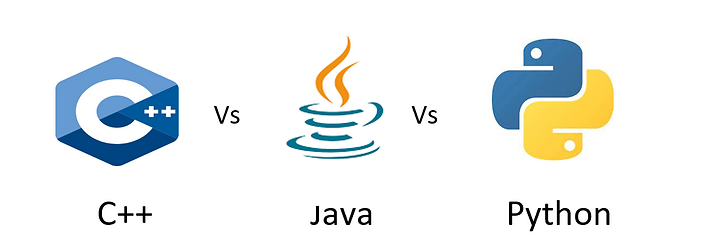
In today’s tech-driven world, Data Structures and Algorithms (DSA) form the foundation of
computer science and software development. Whether you’re preparing for coding
interviews, competitive programming, or building scalable applications, mastering DSA is a
must.
But here’s the real question: Does the programming language you choose make a
difference in learning DSA? The answer is yes. Let’s explore how DSA concepts differ
when you learn them through Python, Java, C, and C++, and how this choice impacts your
career.
🔹 Why Learn DSA (Data Structures & Algorithms)
in the First Place?
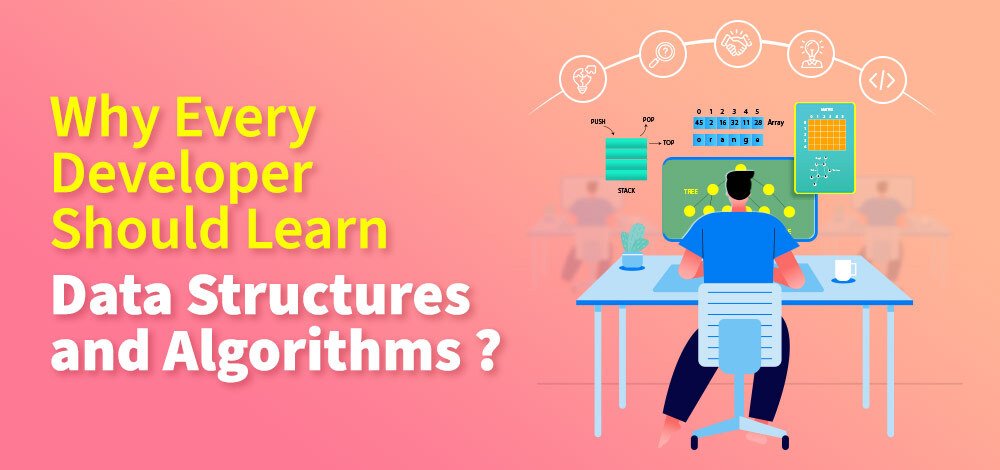
When we talk about building a strong career in software engineering, one word always pops
up – DSA (Data Structures & Algorithms).
For many beginners, it feels like just another subject to study. But in reality, DSA is the
backbone of programming, problem-solving, and technical growth.
Let’s go step by step and see why mastering DSA is a game-changer.
1️⃣Problem-Solving Skills: Thinking Like an Engineer 🧠
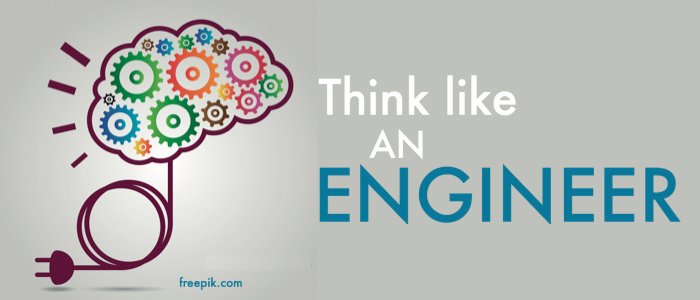
At its core, DSA is not just about writing code—it’s about how you think.
When you face a problem, DSA teaches you to:
● Break it into smaller steps
● Choose the best method (data structure)
● Apply the right process (algorithm) to solve it efficiently.
👉 Example:
Imagine you are designing a food delivery system like Zomato. Thousands of users are
searching for restaurants, filtering cuisines, and tracking delivery boys in real-time. Without
the right data structures like Hash Maps (for quick lookups) or Graphs (for finding the
shortest delivery routes), the system will lag, leading to poor customer experience.
This is where DSA shapes your logical reasoning. You start thinking like an engineer who
doesn’t just solve problems but solves them in the most optimal way.
✅ Benefit: Once you learn DSA, even in daily life, you’ll start approaching problems more
logically—whether it’s managing time, optimizing resources, or debugging a complex bug.
2️⃣Cracking Coding Interviews: Your Golden Ticket 🎯
Whether you want to join Google, Amazon, Microsoft, Adobe, or Flipkart, one common
filter they use is DSA rounds.
Most product-based companies don’t care about how many programming languages you
know at the start. Instead, they care about how you think and solve problems under
pressure.
👉 Example Question:
“Given a map of a city with different roads, find the shortest path between two points.”
This is a Graph problem (solved using Dijkstra’s or BFS/DFS algorithms). Interviewers don’t
want a direct answer; they want to see how you break down the problem and approach it
step by step.
● A candidate who knows DSA can explain multiple approaches (brute force vs
optimized) and why one is better.
● A candidate without DSA knowledge usually struggles or gives inefficient solutions.
✅ Benefit:
Strong DSA knowledge means higher chances of cracking FAANG-level interviews
(Facebook/Meta, Amazon, Apple, Netflix, Google) and landing high-paying jobs.
3️⃣Efficient Development: Writing Code That Scales ⚡
Programming is not just about making things work—it’s about making things work fast and
efficiently.
A beginner might write code that solves a problem, but an engineer with DSA knowledge
writes code that solves it in a fraction of the time and with minimal memory usage.
👉 Example:
Suppose you are searching for a name in a contact list of 10 million users.
● If you use a linear search, it could take seconds.
● If you use a binary search (with sorted data), it reduces to milliseconds.
● If you use a HashMap, you can almost instantly fetch it.
This is the power of DSA.
Another example is in e-commerce apps like Amazon:
● Searching for products
● Suggesting related items
● Optimizing cart checkout
All these depend on efficient use of algorithms and data structures. Without them, the app
would crash under heavy load.
✅ Benefit: With DSA, your code becomes faster, more memory-optimized, and
scalable—something every company values.
⃣Career Growth & High-Paying Roles

In the software world, DSA is the ladder to success.
Most entry-level service-based roles focus only on frameworks and tools. While this is
useful, it has limited growth. On the other hand, product-based companies reward those with
strong problem-solving foundations.
👉 Example:
● A fresher in a service company (without DSA skills) might get ₹3–5 LPA and spend
years doing repetitive tasks.
● A fresher with strong DSA skills can crack companies like Google, Amazon, or
Microsoft and start at ₹20–40 LPA.
Over time, those with DSA knowledge get opportunities to:
● Work on complex system designs
● Contribute to high-impact projects
● Get promoted faster due to their ability to solve critical problems
✅ Benefit: DSA knowledge = faster promotions + global opportunities + higher salaries.
Learning DSA is like building the foundation of a skyscraper. Without it, you may still
code, but your career will always remain limited. With it, you gain:
● Strong logical & analytical skills.
● Confidence to crack top interviews
● Ability to write efficient, scalable programs
● A clear edge in career growth and salary
So, if you’re serious about a long-term successful career in tech, investing time in DSA is
non-negotiable.
When we talk about DSA (Data Structures & Algorithms), a big question often arises:
👉 “Which programming language is best for learning DSA?”
The truth is, DSA concepts remain the same across all languages. An array is an array, a
stack is a stack, and sorting is sorting—whether you implement it in C, C++, Java, or
Python.
But the learning experience varies depending on the language. Each language has unique
features, challenges, and advantages that shape how you understand and implement DSA.
Let’s explore DSA in different programming languages one by one, with detailed insights
and examples.
⃣DSA in C
C is often called the mother of programming languages, and for good reason.
🔹 Low-Level Control
C gives you direct access to memory using pointers, which makes it perfect for learning
the internal working of data structures.
● Example: When you create a linked list, you manually allocate memory using
malloc() and connect nodes using pointers.
● This helps you visualize how data is stored in memory and how pointers link
elements together.
🔹 Manual Effort
Unlike modern languages, C doesn’t provide built-in libraries for data structures. You have to
implement everything from scratch:
● Arrays, Linked Lists, Stacks, Queues → all written by hand.
● Sorting algorithms like Quick Sort, Merge Sort → fully coded by you.
This manual approach forces you to think deeply about how data moves in memory.
🔹 Best For
● Students who want to build a very strong foundation.
● Those preparing for low-level system programming, embedded systems, or OS
development.
🔹 Challenge
● Memory management in C is manual. Forgetting to free memory (free()) leads to
memory leaks.
● Debugging pointer errors can be frustrating.
👉 Example: Creating a dynamic array in C requires manually reallocating memory with
realloc(). In Python, you just use append()—but C forces you to understand what’s
happening under the hood.
✅ Verdict: C is tough but gives you true mastery of how data structures work internally.
⃣DSA in C++
C++ builds on C but adds Object-Oriented Programming (OOP) and a powerful Standard
Template Library (STL).
🔹 Balance of Low-Level & High-Level
● You can still use pointers and memory management like in C.
● But you also get ready-made, optimized data structures via STL.
🔹 STL Magic
The Standard Template Library provides pre-built implementations for:
● Vector → Dynamic array
● Stack & Queue → Ready-made data structures
● Map & Set → Hash maps and trees.
👉 Example: Instead of writing a binary search algorithm manually, you can use
binary_search() from STL.
🔹 Best For
● Competitive programmers (most coding competitions recommend C++).
● Students who want both low-level control and high-level abstractions.
🔹 Challenge
● Syntax is longer than Python.
● Beginners sometimes rely too much on STL and skip understanding how algorithms
work.
✅ Verdict: C++ gives you the best of both worlds—control and convenience. That’s why
it’s the most popular choice for competitive programming.
⃣DSA in Java

Java is a high-level, object-oriented language with strong typing and automatic memory
management.
🔹 Readable & Structured
● No need to manage memory manually (Java has Garbage Collection).
● Data structures like ArrayList, LinkedList, HashMap are available out-of-the-box.
🔹 Widely Used in Interviews
Many companies, especially in enterprise software development, prefer Java.
● Example: In coding interviews at Amazon or Microsoft, Java is one of the top-used
languages.
🔹 Best For ● Students aiming for product-based company interviews. ● Developers already working in Java ecosystems (Spring, backend systems). 🔹 Challenge ● Verbose syntax → writing simple code takes more lines compared to Python. ● Slower than C++ in some competitive coding scenarios. 👉 Example: Creating a HashMap in Java is as simple as: ● HashMap map = new HashMap<>(); ● map.put(“Alice”, 25); ● map.put(“Bob”, 30); In C, you’d spend hours implementing a hash table manually.
✅ Verdict: Java provides a good balance of simplicity and power, making it one of the
safest bets for DSA preparation.
⃣DSA in Python
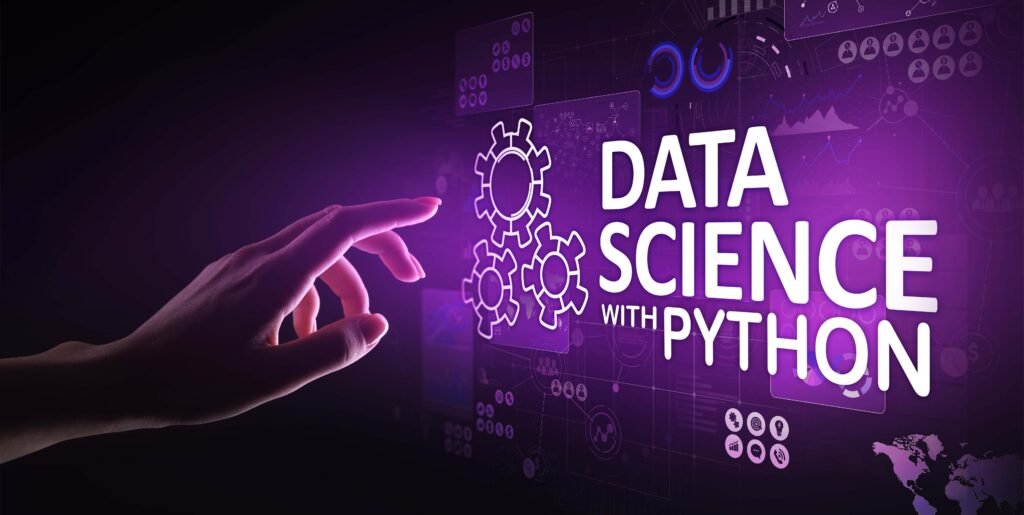
Python is often the first choice for beginners because of its simplicity and readability.
🔹 Quick & Beginner-Friendly
● You don’t need to worry about syntax complexity.
● Focus remains on logic and algorithms instead of language rules.
👉 Example:
Reversing a list in Python is just:
● arr = [1, 2, 3, 4]
● print(arr[::-1])
In C/C++, you’d need loops and swaps.
🔹 Built-In Data Structures
Python provides ready-to-use, flexible structures:
● List → Dynamic array
● Dict → Hash map
● Set → Unique elements collection
● Deque → Efficient queue operations
🔹 Best For
● Beginners starting their DSA journey.
● Developers who want to focus on problem-solving first rather than language
syntax.
🔹 Challenge
● Slower execution speed compared to C++/Java.
● Not ideal for competitive programming, where milliseconds matter.
✅ Verdict: Great for learning and interviews (many companies accept Python solutions),
but not the best for performance-heavy coding competitions.
🔹 DSA in C++: Why It’s the Top Choice for
Programmers
When we talk about Data Structures and Algorithms (DSA), one language often stands
out among learners and professionals alike—C++. It combines the raw power of C with
modern features like Object-Oriented Programming (OOP) and the Standard Template
Library (STL), making it a favorite for both interviews and competitive programming.
Let’s break it down point by point.
⃣OOP + STL Advantage: Power and Convenience
Together ⚡
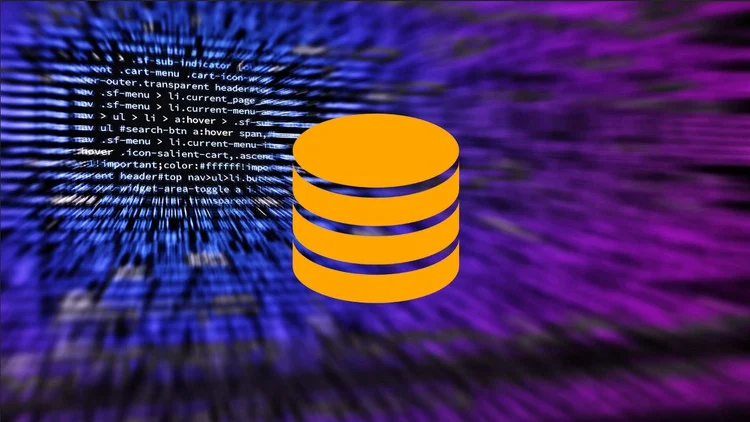
C++ gives you the best of both worlds:
● Like C, it allows low-level control of memory (using pointers, references, manual
allocation if needed).
● But unlike C, it also provides high-level features such as classes, inheritance,
polymorphism (OOP concepts) and, most importantly, the STL (Standard Template
Library).
🔹 What is STL?
The STL is a collection of pre-written, optimized code that provides ready-to-use data
structures and algorithms.
Some of the most widely used STL containers are:
● Vector → A dynamic array that can grow or shrink in size.
● Set / Multiset → Stores unique elements in sorted order (Set) or allows duplicates
(Multiset).
● Map / Multimap → Stores key-value pairs (like Python dictionaries).
● Stack & Queue → Classic LIFO/FIFO structures.
● Priority Queue (Heap) → For tasks like finding the maximum/minimum efficiently.
👉 Example: Instead of writing your own binary search tree, you can simply use std::set in C++. #include #include using namespace std; int main() { set numbers = {5, 1, 8, 3}; numbers.insert(10); for (int n : numbers) { cout << n << ” “; // Output: 1 3 5 8 10 (sorted automatically)
}
return 0;
}
✅ With just a few lines of code, you get a self-balancing tree that keeps everything sorted
internally.
⃣Competitive Programming Favorite
C++ is the undisputed king of competitive programming.
Why?
● Speed: Its execution is much faster than Python, making it ideal for problems where
milliseconds matter.
● STL Shortcuts: In contests, time is limited. STL functions like sort(),
binary_search(), and lower_bound() save hours of coding.
● Flexibility: You can go as deep as low-level memory management or rely on
high-level abstractions.
👉 Example: Suppose you’re solving a shortest path problem in a graph (like finding the
fastest route on Google Maps).
● In C, you’d have to implement everything manually: adjacency lists, queues, and
BFS/DFS logic.
● In Python, the code is shorter but execution might be slower.
● In C++, you can combine efficiency with STL’s priority_queue to implement
Dijkstra’s Algorithm in record time.
That’s why most ICPC winners, Codeforces experts, and LeetCode competitive coders
rely on C++.
⃣Best For: Who Should Learn DSA in C++?

C++ is the perfect choice for:
● Students preparing for coding interviews → Most top companies (Google,
Amazon, Microsoft, Adobe) accept C++ solutions.
● Competitive programmers → Where speed + efficiency + STL are critical.
● Learners who want performance and flexibility → C++ lets you go from high-level
classes to low-level pointer manipulation in the same code.
👉 Example Career Path:
● A student practicing DSA in C++ can solve LeetCode, CodeChef, or HackerRank
problems faster.
● Later, they can sit for coding interviews where 90% of the questions revolve around
DSA.
● Finally, they can use the same C++ knowledge to transition into system-level
programming, game engines, or competitive AI applications.
⃣The Challenge: Steeper Learning Curve
While C++ is powerful, it comes with challenges.
🔹 Verbose Syntax Compared to Python, C++ code looks longer.
For example: Python (reverse a list): arr = [1, 2, 3, 4] print(arr[::-1]) C++
(reverse a vector): #include #include #include using namespace std; int main() {vector arr = {1, 2, 3, 4}; reverse(arr.begin(), arr.end()); for (int n : arr) cout << n << ” “; return 0; }
Both achieve the same output, but C++ requires more typing and boilerplate.
🔹 Higher Entry Barrier
● Beginners may struggle with pointers, references, and memory allocation.
● Using STL blindly without understanding can lead to surface-level knowledge of
DSA.
👉 Example: Many students jump straight to std::map without first learning how a binary
search tree works, which can hurt deeper understanding.
✅ But once you cross the learning curve, C++ gives unmatched flexibility and power.
⃣Real-World Applications of C++ DSA

C++ is not just for learning—it’s widely used in industry:
● Game Development → Engines like Unreal Engine are built in C++ because it’s fast
and memory-efficient.
● System Programming → OS kernels and device drivers often use C++.
● Competitive Coding & CP Platforms → Majority of coders solving problems on
Codeforces, AtCoder, and LeetCode rely on C++.
● High-Frequency Trading Systems → Where speed in microseconds is critical, C++
dominates.
👉 Example: A stock trading system analyzing millions of transactions per second relies
on priority queues and hash maps in C++ to make decisions in real-time.
C++ is the powerhouse of DSA learning.
It offers:
● 🔹 Low-level control (like C)
● 🔹 High-level abstractions (like STL)
● 🔹 Performance and flexibility unmatched by most languages
Yes, it has a steeper learning curve than Python, but that very challenge makes you a
stronger programmer.
✅ If your goal is coding competitions, top product-based interviews, or
performance-critical development, C++ is hands-down the best language for DSA.
🔹 DSA in Java: A Perfect Blend of Structure and
Simplicity.
When it comes to Data Structures and Algorithms (DSA), Java is one of the most widely
chosen languages by students and professionals alike. Unlike C or C++, where developers
often need to handle lower-level details like pointers or memory allocation, Java abstracts
much of that complexity while still providing powerful tools to implement and experiment
with DSA.
Its Object-Oriented nature, platform independence, and rich built-in libraries make Java
an excellent choice for learners who want to strike a balance between clarity and
functionality.
Let’s break it down in detail.
⃣Rich Built-in Libraries: Collections Framework
One of Java’s biggest strengths is its Collections Framework, a set of classes and
interfaces designed to handle common data structures.
🔹 Key Components of the Collections Framework:
● List (ArrayList, LinkedList) → Ordered collections that allow duplicates.
● Set (HashSet, TreeSet, LinkedHashSet) → Stores unique elements, with options
for sorted or insertion-ordered storage.
● Map (HashMap, TreeMap, LinkedHashMap) → Key-value pairs, like dictionaries in
Python.
● Queue & Deque (PriorityQueue, ArrayDeque) → First-In-First-Out or
Double-Ended Queues.
👉 Example: Using a HashMap in Java import java.util.*; public class Example { public static void main(String[] args) { HashMap marks = new HashMap<>(); marks.put(“Alice”, 90); marks.put(“Bob”, 85); marks.put(“Charlie”, 92); for (Map.Entry entry : marks.entrySet()) { System.out.println(entry.getKey() + ” : ” + entry.getValue()); } } } ✅ Output: Alice : 90 Bob : 85 Charlie : 92
Instead of building a hash table from scratch (as in C), Java gives you a ready-to-use
HashMap, which internally handles hashing, collisions, and rehashing.
This saves time in coding interviews and lets students focus on problem-solving rather
than boilerplate code.
⃣Platform Independence: Write Once, Run Anywhere
Another reason Java is highly valued is its platform independence.
● Java code is compiled into bytecode, which runs on the Java Virtual Machine
(JVM).
● This means the same code can run on Windows, Linux, or macOS without
modification.
👉 Why is this important for DSA learners?
● Many coding platforms (HackerRank, LeetCode, Codeforces) support Java out of the
box.
● Enterprise companies that use Java extensively (banks, e-commerce platforms, IT
giants) expect their developers to be fluent in it.
🔹 Example in Real-World Context:
Imagine you design a DSA-based library management system where books are stored in
a TreeMap (automatically sorted by keys).
● On a Windows server, the same program works without changes.
● If migrated to a Linux-based cloud server, it still works flawlessly.
✅ This makes Java an ideal bridge between academic practice and real-world
enterprise deployment.
⃣Best For: Students & Professionals Seeking Growth

Java is widely chosen by: ● Students preparing for product-based company interviews → Companies like Amazon, Flipkart, Infosys, and TCS often prefer Java because of its clarity and reliability. ● Developers aiming for enterprise roles → Many large-scale applications (banking, insurance, government systems) run on Java. ● Learners who prefer clean OOP practices → Unlike C++, where procedural and OOP code often mix, Java enforces a more structured OOP style, which makes large codebases easier to maintain. 👉 Example: If you’re asked to implement a stack in an interview: In C: You need arrays, pointers, manual resizing. In Java: You can directly use Stack or ArrayDeque for efficiency. import java.util.*; public class StackExample { public static void main(String[] args) { Stack stack = new Stack<>(); stack.push(10); stack.push(20); stack.push(30);
System.out.println(stack.pop()); // 30
System.out.println(stack.peek()); // 20
}
}
✅ This approach allows students to focus on algorithm design, not low-level
implementation details.
⃣The Challenge: Slower Execution in Competitive
Programming
Java, while powerful, is slightly slower than C++ in execution.
Why is it slower?
● The JVM adds an extra layer between the code and the machine.
● Garbage collection, while convenient, also consumes time in high-performance
scenarios.
👉 Example:
In competitive programming contests where execution time is critical, a C++ solution might
run in 0.5 seconds, while the same Java solution could take 0.8–1 second.
This doesn’t matter much in interviews or practice, but in high-level competitions, it can be
a deciding factor.
Workaround:
● Use efficient Java classes like ArrayDeque instead of Stack (because Stack is
synchronized and slower).
● Optimize input/output using BufferedReader and StringBuilder instead of
Scanner and System.out.println ( ).
⃣Real-World Applications of DSA in Java
Java’s popularity extends far beyond classrooms and coding interviews.
Some areas where DSA in Java is widely applied:
● Enterprise Applications: Banking systems (ICICI, SBI backend), e-commerce
giants (Amazon, Flipkart) heavily use Java.
● Android Development: Though Kotlin is rising, Java is still the backbone of millions
of Android apps.
● Big Data & Distributed Systems: Tools like Hadoop, Spark, and Kafka are built with
Java at their core.
● Backend Development: Many Spring Boot applications rely on Java + DSA to
handle requests, caching, and data storage efficiently.
👉 Example:
Consider a food delivery app like Swiggy or Zomato.
● Orders might be stored in a Queue (FIFO).
● Delivery agents might be assigned based on Priority Queues (closest agent first).
● Customer data might be indexed with HashMaps for fast lookup.
All of these can be efficiently managed with Java’s built-in libraries
Java is the middle ground in the DSA journey:
● Easier to learn than C++ (no pointers, simpler syntax).
● More structured due to OOP principles.
● Backed by powerful built-in libraries like the Collections Framework.
Yes, it’s slower than C++ in raw speed, but its clarity, reliability, and industry relevance
make it an excellent choice.
✅ If your goal is enterprise roles, product-based company interviews, or
Android/backend development, learning DSA in Java will give you a solid advantage.
🔹 DSA in Python: Simplicity Meets Power
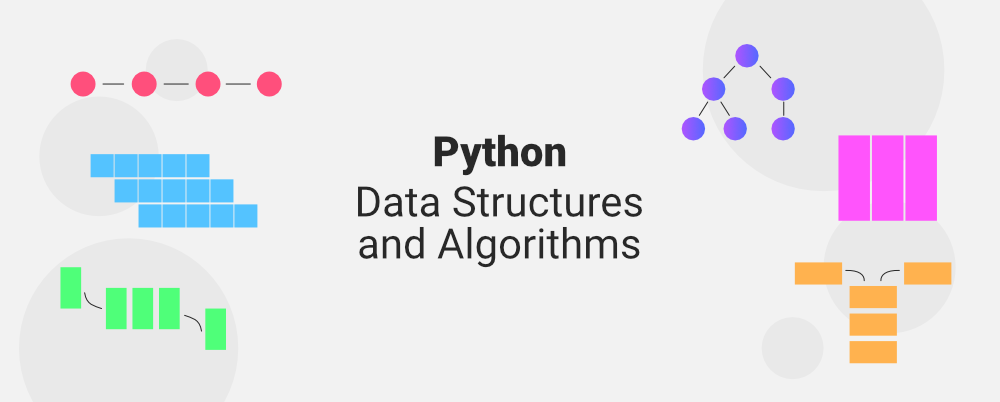
When learning Data Structures and Algorithms (DSA), one of the biggest challenges for
beginners is syntax complexity. For many, dealing with semicolons, curly braces, pointers,
and memory management in C or C++ becomes overwhelming. This is where Python
shines.
Python’s beginner-friendly syntax, built-in data types, and expressive language style
make it the most approachable language for anyone starting their DSA journey. It allows
learners to focus purely on logic and problem-solving instead of worrying about technical
boilerplate.
Let’s explore Python for DSA in detail.
⃣Beginner-Friendly Syntax: Focus on Logic, Not
Syntax
Unlike C++ or Java, Python does not require you to declare variable types, manage memory, or write long code for simple operations. Its clean syntax ensures that you think in algorithms rather than syntax rules. 👉 Example: Implementing a simple stack in Python vs C++. In C++ (longer, more complex): #include #include using namespace std; int main() { stack s; s.push(10); s.push(20); s.push(30); cout << s.top() << endl; // 30 s.pop(); cout << s.top() << endl; // 20 return 0
}
In Python (short, readable):
stack = []
stack.append(10)
stack.append(20)
stack.append(30)
print(stack[-1]) # 30
stack.pop()
print(stack[-1]) # 20
✅ Same logic, half the code.
This simplicity makes Python the go-to choice for interview prep and early learners.
⃣Pre-Built Data Types: Fast, Reliable, and Easy
Python provides highly optimized built-in data structures that replace the need to implement
everything from scratch.
🔹 Key Data Types in Python:
● List → Works like dynamic arrays.
● Tuple → Immutable sequences (good for fixed data).
● Set → Stores unique elements, supports fast union/intersection.
● Dictionary → Hash maps (key-value pairs) for quick lookups.
● Deque (from collections module) → Efficient double-ended queue.
● Heap (from heapq module) → Min-heaps for priority-based problems.
👉 Example: Using a dictionary to store student grades.
grades = {“Alice”: 90, “Bob”: 85, “Charlie”: 92}
for name, marks in grades.items():
print(name, “:”, marks)
✅ Output:
Alice : 90
Bob : 85
Charlie : 92
In C/C++, building such a map requires manual hash table implementation or STL usage.
In Python, it’s built-in and lightning fast.
This allows you to directly practice problem-solving (like LeetCode/Codeforces questions)
instead of wasting time writing boilerplate code.
⃣Best For: Beginners, Data Science Aspirants &
Interview Prep 🎯
Python has earned a reputation as the Swiss Army Knife of programming.
● For beginners → Python’s readability ensures they learn logic before syntax.
● For interview prep → Companies often don’t judge candidates on syntax but on
problem-solving ability. Python helps focus on the core algorithm.
● For data science aspirants → Since Python dominates AI/ML, Data Science, and
Web Development, learning DSA in Python is a natural choice.
👉 Example in interviews:
A candidate asked to reverse a string can write:
s = “hello”
print(s[::-1]) # olleh
✅ One line in Python vs multiple lines in C/C++.
This time-saving aspect gives candidates extra minutes in coding tests to focus on harder
problems.
⃣The Challenge: Slower Execution Time ⏳
While Python is elegant, its execution speed is slower compared to C++ or Java.
Why is Python slower?
● It is an interpreted language, not compiled directly into machine code.
● Dynamic typing adds overhead.
● Built-in structures, while optimized, are not as fast as C++’s STL containers.
👉 Example:
● In competitive programming, a Python solution handling 10⁷ operations might time
out, while C++ executes it easily.
● Problems involving big integer operations are handled smoothly in Python (since
integers are unlimited), but raw performance in tight loops lags behind.
⃣Real-World Applications of DSA in Python
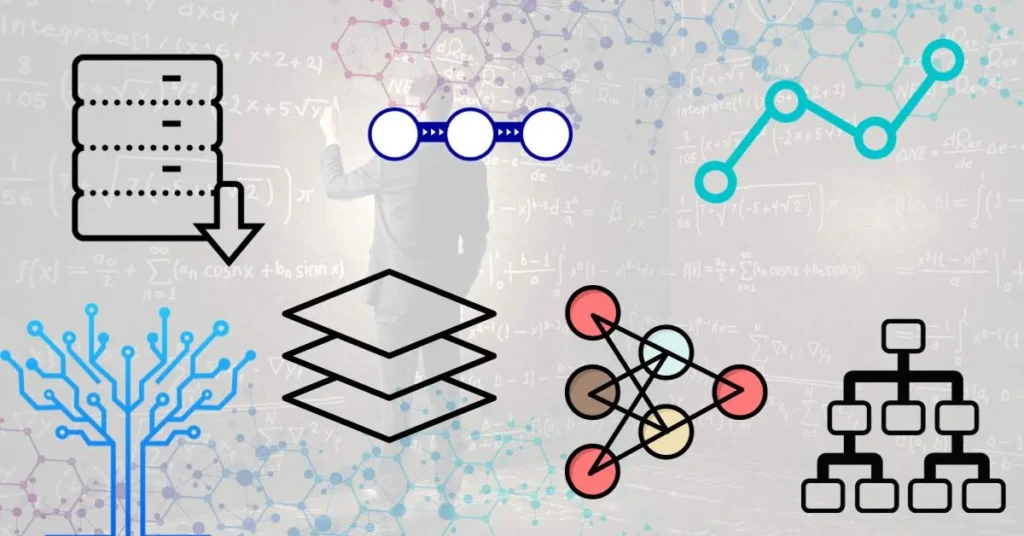
Python isn’t just a learning tool — it’s a language with real-world impact.
Some major areas where DSA in Python is applied daily:
● Machine Learning & Data Science → Libraries like NumPy, Pandas rely on
optimized data structures (arrays, dataframes).
● Web Development → Frameworks like Django/Flask use dictionaries, queues, and
caching under the hood.
● Automation & Scripting → Python scripts automate file systems, APIs, and
scheduling using efficient data structures.
● AI/ML Algorithms → Neural networks and graph algorithms use Python data
structures extensively.
👉 Example: AI Pathfinding
Using a priority queue in Python for Dijkstra’s algorithm:
import heapq
graph = {
‘A’: [(‘B’, 1), (‘C’, 4)],
‘B’: [(‘C’, 2), (‘D’, 5)],
‘C’: [(‘D’, 1)],
‘D’: []}
def dijkstra(start):
pq = [(0, start)]
distances = {node: float(‘inf’) for node in graph}
distances[start] = 0
while pq:
curr_dist, node = heapq.heappop(pq)
for neighbor, weight in graph[node]:
distance = curr_dist + weight
if distance < distances[neighbor]:
distances[neighbor] = distance
heapq.heappush(pq, (distance, neighbor))
return distances
print(dijkstra(‘A’))
✅ Output:
{‘A’: 0, ‘B’: 1, ‘C’: 3, ‘D’: 4}
This shows how Python allows you to write complex algorithms like Dijkstra with minimal
syntax overhead.
6️⃣Python vs Other Languages in DSA
● Python vs C → Python removes low-level complexity (pointers, memory allocation).
● Python vs C++ → Python is slower, but easier. C++ is better for competitive
programming.
● Python vs Java → Python is more concise, Java is more structured and
industry-standard.
👉 In short:
● Learn in Python → for logic, readability, and interviews.
● Practice in C++ → for contests and speed.
● Use Java → for enterprise and industry projects.
Python is like the friendly teacher of DSA — approachable, easy to understand, and highly
effective for beginners.
● ✅ Clean syntax → Focus on logic.
● ✅ Built-in structures → Faster problem-solving.
● ✅ Great for interviews and real-world applications.
● ❌ Slower execution → Not ideal for time-sensitive contests.
🔹 Which Language Should You Choose for DSA?
When starting your journey in Data Structures and Algorithms (DSA), one of the most
common questions students face is:
👉 “Which programming language should I use?”
The truth is: DSA concepts remain the same in every language. What changes is how
easily and efficiently you can implement them.
Think of it this way:
● The mathematics of DSA is language-independent.
● But the tools and syntax provided by each language influence your learning speed,
performance, and career applications.
Let’s look at the four most popular languages for DSA — C, C++, Java, and Python — in
detail.
1️⃣C → The Foundation Builder
C is often called the mother of all programming languages.
It is close to the hardware, simple, and powerful.
🔹 Why choose C for DSA?
● Strong basics: C forces you to understand how memory, arrays, pointers, and data
structures work at the lowest level.
● Manual implementation: You have to write everything from scratch (linked lists,
stacks, queues, trees), which builds a strong foundation.
● Lightweight & fast: No extra overhead; C programs run extremely fast.
👉 Example: Creating a linked list in C requires you to manually allocate memory with
malloc() and use pointers to connect nodes. This might feel difficult, but it helps you truly
understand how linked structures are stored in memory.
🔹 Challenge:
● No built-in libraries: Everything must be implemented manually.
● Complex syntax with pointers: Beginners often struggle.
✅ Best for: Students who want deep understanding of internals and a strong
foundation in computer science.
2️⃣C++ → The Competitive Programmer’s Weapon
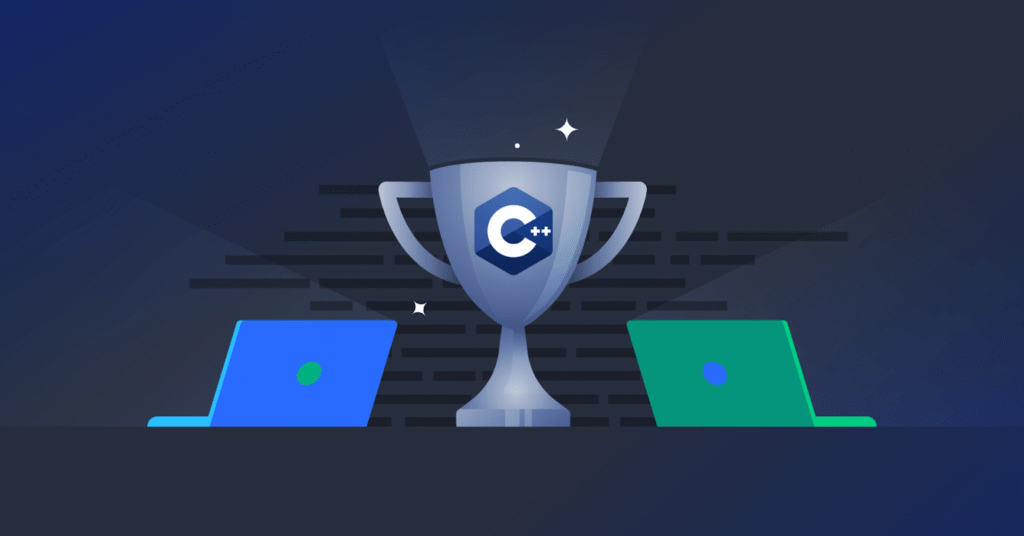
C++ is like C, but with extra power — Object-Oriented Programming (OOP) + Standard Template Library (STL). 🔹 Why choose C++ for DSA? ● OOP + Low-level control: You still get pointers and memory control, but with the structure of classes and objects. ● STL advantage: Ready-made implementations of vectors, sets, maps, queues, priority queues, etc. ● Fast execution: Critical for competitive programming and coding contests. 👉 Example: Solving a shortest-path problem using priority_queue in C++ takes 5–10 lines, while in C you’d write 50+ lines. #include using namespace std; int main() { priority_queue, greater> pq; pq.push(10); pq.push(5); pq.push(20); cout << pq.top(); // 5 }
🔹 Challenge:
● Steeper learning curve than Python.
● Syntax-heavy compared to Java or Python.
✅ Best for: Students preparing for coding competitions and product-based company
interviews.
⃣Java → The Enterprise Favorite
Java sits in between low-level control (like C++) and high readability (like Python). 🔹 Why choose Java for DSA? ● Collections Framework: Built-in implementations like ArrayList, HashMap, TreeSet, etc. ● Cleaner OOP practices: Forces you to think in objects and classes, which is useful in large projects. ● Platform independent: Runs anywhere via JVM, making it perfect for enterprise-scale systems. 👉 Example: Implementing a HashMap in Java is very simple: HashMap map = new HashMap<>(); map.put(“Alice”, 90); map.put(“Bob”, 85); System.out.println(map.get(“Alice”)); // 90 🔹 Challenge: ● Slower execution than C++ in contests. ● Verbosity: Code is longer than Python. ✅ Best for: Students aiming for enterprise jobs, product-based companies, and clean OOP practices.
⃣Python → The Beginner’s Gateway
Python is the most beginner-friendly language for DSA.
Its simple syntax and built-in data types let students focus entirely on logic.
🔹 Why choose Python for DSA?
● Beginner-friendly: Easy to read and write (like plain English).
● Pre-built data types: Lists, sets, and dictionaries make coding fast.
● Great for interviews & AI/ML: Helps you solve algorithmic problems without syntax
struggle.
👉 Example: Priority Queue using heapq in Python:
import heapq
pq = [10, 5, 20]
heapq.heapify(pq)
print(heapq.heappop(pq)) # 5
🔹 Challenge:
● Slower execution: Not ideal for competitive programming with huge input sizes.
● Less control: Abstracts away low-level details.
✅ Best for: Beginners, interview prep, and data science/AI aspirants.
⃣The Big Question: Which One Should You Choose?
Here’s how you can decide based on your goals:
● If you want strong fundamentals → Choose C.
Example: You’ll understand how a pointer actually traverses a linked list.
● If you want to ace coding contests → Choose C++.
Example: On Codeforces/LeetCode, 70–80% of top competitive coders use C++.
● If you want enterprise or product-based jobs → Choose Java.
Example: Amazon and Infosys often hire Java developers with strong DSA.
● If you’re a beginner or aiming for AI/ML → Choose Python.
Example: Many Google interviewees code in Python because of its clarity and
built-in data structures.
🔹 Career Impact of Learning DSA
Learning Data Structures and Algorithms (DSA) is often considered the single most
important investment for anyone who wants to build a career in software development.
Why? Because while frameworks, tools, and even programming languages change every
few years, DSA remains timeless.
Let’s explore its career impact in detail:
⃣Top Companies Demand It
When it comes to software engineering interviews, especially in FAANG (Facebook,
Amazon, Apple, Netflix, Google) and other top product-based companies, DSA is the #1
skill tested.
🔹 Why?
● Projects and frameworks show you can use tools.
● But DSA shows how well you can think, analyze, and solve problems.
These companies want to know:
👉 If you face a problem that doesn’t already have a library or built-in function, can you
solve it logically and efficiently?
📌 Example:
Imagine you are applying for Google. Instead of asking:
“How would you use React to build a webpage?”
They ask:
“Given an array of 1 million integers, find the first duplicate element efficiently.”
Here, your knowledge of hashing, time complexity, and memory trade-offs decides
whether you get the job, not your ability to use React or Django.
🔹 Real Interview Scenario:
● Amazon often asks about binary search trees, dynamic programming, or graph
traversal.
● Microsoft may give problems related to arrays and strings with edge cases.
● These are all DSA-focused questions.
✅ Takeaway: Without strong DSA skills, clearing initial interviews at top companies is
nearly impossible, regardless of how many projects you’ve built.
⃣Coding Competitions & Hackathons
Competitive programming platforms like Codeforces, CodeChef, LeetCode, AtCoder, and
HackerRank thrive on DSA.
🔹 Why is this important for careers?
● Many companies host hiring contests where you solve DSA challenges.
● Winning or ranking well gives you a direct interview call.
● It builds problem-solving speed—a must-have skill for timed coding rounds.
📌 Example:
● A candidate solving a graph shortest path problem in 20 minutes (using Dijkstra’s
Algorithm with a priority queue in C++) will stand out from someone struggling with
brute force solutions in Python.
● Competitions like Google Kick Start or Facebook Hacker Cup often feature such
problems.
🔹 Language Choices Here:
● C++ and Java dominate because of speed + STL/Collections.
● Python users can still excel if they optimize well, but execution time sometimes
becomes a bottleneck in very large inputs.
✅ Takeaway: If you want to shine in coding contests or hackathons that lead to job
opportunities, mastering DSA is essential.
3️⃣Versatility Across Languages
One of the most overlooked but powerful impacts of learning DSA is that it makes you
language-independent.
🔹 Why does this matter?
● Today you might learn Java in college.
● Tomorrow your company might require Python for data science or Go for system
programming.
● If your DSA foundation is strong, switching is easy—because the underlying logic
doesn’t change.
📌 Example:
● A binary search tree works the same way in C, C++, Java, or Python.
● The syntax differs, but the concept of recursive insertion, deletion, and traversal
stays identical.
// In C++: Inorder traversal
void inorder(Node* root) {
if (!root) return;
inorder(root->left);
cout << root->data << ” “; inorder(root->right);}
In Python: Inorder traversal
def inorder(root):
if not root:
return
inorder(root.left)
print(root.data, end=” “)
inorder(root.right)
Both do the same thing. If you understand the algorithm, learning the syntax is just a
matter of practice.
🔹 Career Benefit:
● You become adaptable, which is a key skill employers look for.
● A strong DSA base means you can move from web development → system
programming → AI/ML without much struggle.
✅ Takeaway: DSA mastery gives you career flexibility across domains and languages.
⃣Faster Growth & Higher Salaries
DSA doesn’t just get you the job—it helps you grow in your career too.
🔹 How?
● At senior levels, you’ll often face problems involving large-scale systems,
optimization, and performance bottlenecks.
● Someone who understands time complexity and space optimization will always be
more valuable.
📌 Example in Industry:
● A fintech company processing millions of transactions per day needs algorithms
that run in near O(log n) or O(n).
● If your code runs in O(n²) because you didn’t optimize, it could mean huge costs
and delays.
This is why top-paying companies reward DSA mastery with better roles and salaries.
✅ Takeaway: Strong DSA skills = faster promotions, more responsibility, and better pay.
⃣Problem-Solving Beyond Coding

Interestingly, DSA also impacts how you solve real-life problems outside of code.
🔹 Example:
● If you’re good at DSA, you’ll start breaking down a problem into smaller steps
automatically.
● Need to organize a team project? You might think of it as a queue system (first-in,
first-out).
● Need to find the shortest path to your office avoiding traffic? That’s basically
Dijkstra’s Algorithm in action.
Employers love candidates who think logically and structure solutions clearly, not just
write code.
In Short:-
The career impact of learning DSA is massive:
- Top companies demand it → It’s the ticket to FAANG & product-based jobs.
- Coding competitions rely on it → Helps you get noticed and hired.
- Versatility across languages → Future-proof your career.
- Faster growth & higher salaries → Optimize systems at scale.
- Problem-solving mindset → Makes you valuable beyond coding.
👉 If coding were a sport, DSA is the gym where you train your mind.
The stronger your DSA skills, the more you can adapt, perform, and succeed in your
software career.
🔹 How Pinaki IT Hub Can Help You Master DSA
At Pinaki IT Hub, we understand that learning DSA isn’t just about coding—it’s about
building career-ready problem solvers. Here’s how we help:
✅ Structured Training → Step-by-step guidance in DSA using C, C++, Java, and Python.
✅ Hands-On Practice → Real-world coding challenges & mock interview questions.
✅ Industry-Ready Skills → We prepare you not just for interviews but for real
development roles.
✅ Expert Mentorship → Guidance from professionals who have cracked top
product-based companies.
Whether you’re just starting out or preparing for your dream company, Pinaki IT Hub gives
you the roadmap and support you need to succeed.
👉 Start your DSA journey today with Pinaki IT Hub.



